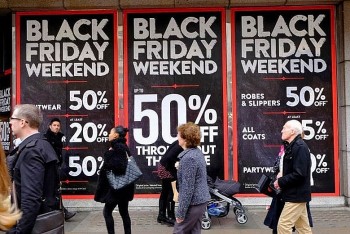Black Friday vs. Buy Nothing Day: A fun, detailed comparison
When it comes to the Friday after Thanksgiving, two wildly different events battle for attention: Black Friday, the world’s biggest shopping day, and Buy Nothing Day, a protest against consumerism. Both offer unique perspectives on how we spend (or don’t spend) our money, time, and energy. This lighthearted comparison dives into the numbers, stories, and tips surrounding these two cultural phenomena.
 |
| Black Friday is well known as the day when retailers slash prices to kick off the holiday shopping season and clear out stock ahead of the new year |
1. What Is Black Friday?
Black Friday is a shopping extravaganza where retailers slash prices, offering massive discounts to kick off the holiday season. Originating in the United States, it has spread globally to countries like Canada, the UK, and Australia.
-
Facts and Figures:
- In 2023, Americans spent $9.8 billion online during Black Friday alone.
- Over 150 million people shopped in the US on Black Friday weekend in 2022.
- Popular items include electronics (40% of sales), clothes (25%), and toys (15%).
-
A Fun Story:
Black Friday got its name from Philadelphia police officers in the 1960s. They used it to describe the chaotic crowds and traffic jams caused by post-Thanksgiving shoppers. What started as a negative term turned into a positive one as retailers embraced the “black ink” from their soaring profits.
-
 Top 5 Reasons Why Americans Can't Stop Shopping on Black Friday
Top 5 Reasons Why Americans Can't Stop Shopping on Black Friday The American enthusiasm for bargain hunting, especially during high-profile sales like Black Friday, can be traced to a combination of cultural, economic, psychological, and historical ...
2. What Is Buy Nothing Day?
Buy Nothing Day, founded in 1992 by Canadian artist Ted Dave, is a counter-movement to Black Friday. It encourages people to skip shopping for 24 hours to reflect on overconsumption and sustainability.
 |
| Buy Nothing Day has been held on the same day as Black Friday. The rules are simple. Just don’t buy anything at all for 24 hours. |
-
Facts and Figures:
- Observed in over 65 countries worldwide.
- In 2021, more than 1 million participants pledged to avoid spending.
- Activities include “credit card cut-ups,” free workshops, and clothing swaps.
-
A Fun Story:
In Sweden, activists once staged a “zombie walk” in malls on Buy Nothing Day, symbolizing how shoppers mindlessly consume. Their message: “Wake up and think before you buy!”
3. Black Friday vs. Buy Nothing Day: Key Differences
| Category | Black Friday | Buy Nothing Day |
|---|---|---|
| Goal | Shop till you drop! | Pause, reflect, and resist. |
| Activities | Hunting deals, waiting in lines. | Protests, discussions, relaxing. |
| Biggest Fans | Retailers and bargain hunters. | Environmentalists and minimalists. |
| Budget Impact | Often leads to overspending. | 100% money-saving guaranteed! |
4. Funny Moments From Black Friday
- The TV Tussle: In 2014, two shoppers in Texas wrestled over a discounted TV. The loser reportedly vowed to “just watch Netflix instead.”
- Black Eye Friday: Some UK stores had to call the police in 2015 due to fights over items like discounted toasters and kettles.
 Black Friday 2024 in US: What to Expect from Amazon, Apple, and Other Major U.S. Retailers Black Friday 2024 in US: What to Expect from Amazon, Apple, and Other Major U.S. Retailers |
 Black Friday 2024 weather in the U.S: How it affects Shopping plans Black Friday 2024 weather in the U.S: How it affects Shopping plans |
5. Tips for a Balanced Approach
If you love Black Friday but also care about the planet, try these:
- Tip 1: Shop for essentials only. A $100 jacket for $50 isn’t saving money if you don’t need it!
- Tip 2: Support local businesses offering eco-friendly products.
- Tip 3: Set a strict budget to avoid regretful spending.
On Buy Nothing Day:
- Tip 4: Spend the day outdoors, enjoying nature for free.
- Tip 5: Organize a “swap party” where friends exchange items instead of buying new ones.
- Tip 6: Volunteer at a charity instead of heading to the mall.
6. Surprising Statistics
- On average, Americans spend $430 per person on Black Friday.
- 90% of Black Friday deals are repeated or recycled from earlier sales, according to a 2022 study.
- Over 30% of Buy Nothing Day participants report feeling less stressed after skipping shopping.
7. Why Both Days Matter
-
The Case for Black Friday:
For many, it’s a fun tradition. Families bond over finding deals, and it’s an opportunity to afford items that might otherwise be out of reach. Retailers also rely on this day to boost their revenue.
-
The Case for Buy Nothing Day:
It’s a wake-up call to re-evaluate our habits. With 85% of Black Friday items ending up in landfills within six months, Buy Nothing Day encourages mindful spending and sustainable living.
8. Can You Celebrate Both?
Yes! You can shop responsibly on Black Friday and take a break on Buy Nothing Day. For example:
- Shop online to avoid crowded stores (less gas, less stress).
- Focus on buying long-lasting, high-quality items instead of cheap, disposable ones.
- Balance shopping with activities that align with Buy Nothing Day’s values, like donating to charity.
| FAQs 1. Which day is more popular? Black Friday attracts millions worldwide, while Buy Nothing Day has a smaller but growing following. 2. Can I shop ethically on Black Friday? Yes. Look for stores offering sustainable or secondhand products, and avoid impulse buys. 3. How do I participate in Buy Nothing Day? Simply avoid spending for 24 hours! You can also join events like swap meets or host a “zero-spending” dinner with friends. 4. What’s the environmental impact of Black Friday? Black Friday contributes to waste and carbon emissions from manufacturing, shipping, and discarded goods. Buy Nothing Day aims to reduce these impacts. 5. Are Black Friday deals really worth it? Some are, but research shows many discounts are similar to sales earlier in the year. Always compare prices before buying. 6. What’s the most expensive Black Friday purchase? In 2022, a limited-edition luxury car in Dubai sold for $5 million during a Black Friday event. 7. What happens if everyone joined Buy Nothing Day? Retailers would see major losses, but it could also spark a shift toward more sustainable business practices. 8. What are some fun Buy Nothing Day alternatives? Have a movie marathon at home. Go for a hike with friends or family. DIY gifts for the holidays instead of buying. 9. Is there a compromise between the two days? Yes, “Buy Less Day.” Spend thoughtfully on Black Friday and avoid unnecessary purchases. 10. Which day saves more money? Hands down, Buy Nothing Day wins here—you’re not spending a single penny! |
In the end, whether you dive into Black Friday shopping or embrace the simplicity of Buy Nothing Day, the choice reflects your values and priorities. Both days can teach us something valuable—either about finding the best deals or appreciating what we already have.




























